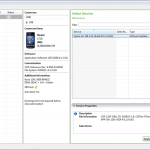No holds barred -- Windows RT can be jailbroken

What's the first thing that springs to mind when you encounter the term "jailbroken"? Naturally, iPad, iPhone or iOS are among the most likely answers, but what about Windows RT? Microsoft's tablet operating system also embodies a walled garden principle, however, similar to some Apple products, a developer uncovered a method to run unsigned apps, by exploiting a kernel vulnerability.
The jailbreaking method currently available for Windows RT is aimed at more advanced users that are familiar with modifying system files, as there is no installer or one-click-to-jailbreak solution ready. Daring users have to change the minimum signing level from "8" (also known as "Microsoft" level) to "0" (also known as "Unsigned"), the latter, which is the default value for the x86 counterpart, Windows 8. Sounds easy, but the process is not.
AOKP Jelly Bean MR1 Build 1 available

Little more than three months since the last build, breaking away from the previous Sunday release schedule, the team behind Android Open Kang Project (AOKP) unveiled Jelly Bean MR1 Build 1. The latest build represents the first official release based on Android 4.2, sporting most of the custom distribution's traditional features.
The work on Android 4.2-based builds started from scratch after Google released the latest green droid operating system, a "tough decision" according to the team behind AOKP. At the moment, Jelly Bean MR1 Build 1 delivers most of the previously known features such as widely customizable navigation bar, including buttons, color or widgets to name a few, custom vibrations, LED Control, lockscreen targets, Quiet Hours and advanced sound settings, among others. However, there are some new features included as well.
Building Android from AOSP -- goals, setbacks and achievements

"How hard can it be?" is a question that I have hopelessly asked myself too many times down the road. The answer is almost never "Give me five minutes and I'm done" because for me there's no such thing as an easy task to undertake. Case in point is my latest hobby, if it can be named as such, building Android 4.2 Jelly Bean from the Android Open Source Project. Do you still remember the question?
The idea is to get a working Android 4.2 Jelly Bean-based build with only minor alterations, that I apparently cannot find anywhere else combined in an already available custom distribution. My requirements are fairly simple at first glance, as I only want a center clock, blacked-out Settings menu, to remove a few tiles and add new ones and, maybe, add some Linaro optimizations to the build. Straightforward, right?
Verizon Samsung Galaxy Note II Developer Edition arrives too late

When Verizon Wireless introduced the Samsung Galaxy Note II, the handset shipped with a fairly restrictive modding setup. It could not be rooted early on and there was also the problem of a tightly locked bootloader, both of which are now sorted out. But after the major obstacles are gone the big red Galaxy Note II Developer Edition surfaces with, you guessed it, an unlocked bootloader. But is it worth it?
The Galaxy Note II Developer Edition comes with the same impressive specifications as the standard version. The smartphone features a 5.5-inch Super AMOLED display, 1.6GHz quad-core processor backed by 2GB of RAM and a whopping 3,100 mAh battery. The 16GB of internal storage as well as the microSD card slot are carried over, just like Android 4.1 Jelly Bean with TouchWiz running on top. Fairly straightfoward, except the unlocked bootloader.
Official CyanogenMod 10.1 builds starting to surface

Modders, get your tools ready! Little short of three weeks after the team behind the popular custom Android distribution CyanogenMod introduced official builds for the Nexus 4 and Nexus 10, CM 10.1 nightly releases are starting to make their way onto more supported devices.
At the time of writing this article CyanogenMod 10.1 builds are available for the Samsung Galaxy S III (codename "I9300", "d2att" and "d2tmo"), Galaxy S II (codename "I9100" and "I9100G"), Galaxy S (codename "I9000" and "I9000B"), Galaxy Nexus (codename "maguro"), Google Nexus 7 (codename "grouper"), as well as ASUS Transformer Pad Infinity ("codename "tf700t"). The latest nightly release, dated December 17, is based on Android 4.2.1 Jelly Bean, build number JOP40D, and delivers a significant number of features, either ported from previous iterations of the custom distribution or adapted for the new version of Android.
Android manufacturers should embrace modding

Android modding is often perceived as a rare disease that must be treated at all costs with tightly locked bootloaders and impossible to root devices. When users do want to remove the shackles imposed by manufacturers, and carriers alike, there's always a sense that someone will suddenly knock on the door and say: "Stop, we'll void your warranty. Your device must run unadulterated software!" That's just limited thinking. Modding is beneficial and not just for those roaming around in obscure corners of the interwebs.
Some argue that modding is just that insignificant other that is over-hyped per the overall scheme of things. When enthusiasts ask for unlocked bootloaders or maybe easier to root devices, those very same people will shorty argue with "Most people don't need that, so your wish doesn't matter!" Obviously there's some "truth" to that, because in most cases the deniers don't bother to read thousands of forum posts or even to check custom Android distribution statistics. Yes, there are such things.
Get Google Now on Ice Cream Sandwich

People that want to try out Google's latest voice assistant on green droid devices are confined by the search giant to use either of the two Jelly Bean iterations. However, Google Now also makes its way onto Ice Cream Sandwich through third-party app GNow Handlebars.
Previous to GNow Handlebars, the process of installing Google Now onto Android 4.0 mostly involved flashing files in a custom recovery like ClockworkMod or TWRP. Now the same result can be achieved simply by opening the app and selecting the voice assistant to kick off the installation. There is also a restore option available that brings back the older Google Search, which should come in handy if something goes wrong.
Unofficial CyanogenMod 10.1 available for the international Samsung Galaxy S III

Just over a week ago, Steve Kondik, the founder of the popular custom distribution CyanogenMod, revealed that CM10.1 builds based on Android 4.2 Jelly Bean will soon be released for US variants of the Samsung Galaxy S III. However, the highly anticipated custom ROM is already available for the international model, albeit with unofficial tags.
Galaxy S III users that want to install the unofficial builds can expect a similar functionality to the official CM10.1 releases available today. As the feature porting process is not completed, it won’t come as any surprise that some of the features included in previous CyanogenMod iterations are still missing or not yet adapted for Android 4.2 Jelly Bean. Due to the unofficial nature and the infancy of the source code, users may also encounter some bugs as well.
The unofficial CyanogenMod 10.1 release can be installed just like any other by flashing the available build and the adjacent Google Apps package using a compatible custom recovery tool such as ClockworkMod or TWRP.
Samsung Galaxy Note II for Verizon Wireless now has an unlocked bootloader

Among the modding community, Android devices from Verizon Wireless are known for limited modding capabilities. Samsung Galaxy Note II is no different, however, its stigma is slowly fading. The handset can run apps with elevated privileges, and now the bootloader can be unlocked as well.
An unlocked bootloader may not appeal to less demanding users, but holds a great deal of importance to enthusiasts that want to install custom Android distributions, third-party recoveries or kernels. But in order to get even a whiff of all the goodies, Galaxy Note II users first have to install a new Partition Information Table and a custom ROM. Afterwards an exploit must be run in order to install the PIT file (again) and flash the insecure (unlocked) bootloader as well as the new recovery.
Sony releases tool to restore factory software on Xperia smartphones, and the modding community likes it

Japanese manufacturer Sony has announced the release of a beta tool that can be used to restore factory software on a number of Xperia smartphones. The program targets green droid modders that wish to go back to stock, after running custom distributions such as CyanogenMod 10.
Sony says that the beta tool is released at the request of the Android community and currently works for the Xperia S, Xperia arc and Xperia arc S, with plans to increase the number of supported devices. At the moment users only have the ability to restore to a single software variant on each smartphone, but the Japanese manufacturer says it intends to include a wider version selection in the future.
CyanogenMod 10.1 nightly builds available for Google Nexus 10, soon for US Samsung Galaxy S IIIs

Almost a week ago the team behind the popular custom Android distribution CyanogenMod announced that Android 4.2-based nightly builds for the Google Nexus 10 were on the way. The developers kept their word and have now delivered the first official CyanogenMod 10.1 release for the 10-inch tablet.
The CM10.1 builds for the Nexus 10 (codename "Manta") are available with December 3 and December 4 time-stamps. Users should expect a number of features to be missing due to the early nature of the development and on-going feature porting process. However, Quiet Hours, the battery percentage indicator, and Trebuchet launcher are all included. Steve Kondik, the project's founder, has further good news for CyanogenMod fans.
Samsung Galaxy Note II for Verizon Wireless can now be rooted -- users pay to unlock the bootloader

Android devices from Verizon Wireless are known among the modding community as fairly restrictive when it comes to rooting or unlocking the bootloader. The Samsung Galaxy Note II, now available at the big red, is no exception, but the controversial smartphone can be modded to run apps using elevated privileges, with plans to unlock the bootloader as well.
The process is fairly simple to carry out and can enrich the software experience by allowing users to perform otherwise restricted tasks, such as disabling carrier-branded apps or making full-system backups. In order to unlock the modding gates on the Galaxy Note II, Odin, the Samsung driver, and a modded stock image with elevated rights enabled must be downloaded. Then "system.img" has to be extracted from the stock image and used in the flashing tool to finally get root up and running. But what about the bootloader?
Google Nexus 4 and 10 get official CyanogenMod 10.1 nightly build

If you're one of the lucky few Google Nexus 4 or Nexus 10 owners around the world that prefer a third-party ROM to Android 4.2 Jelly Bean, then you're in luck. Today the team behind the popular CyanogenMod custom distribution released an official CM10.1 build for the LG-made smartphone, with another on the way for its tablet sibling.
The CyanogenMod 10.1 build for the Nexus 4 comes in response to unofficial custom distributions, that recently surfaced, built using the former's source code. The first release available to the general public is based on Android 4.2 Jelly Bean, rather than the newest version issued yesterday. However a missing December in the People app is unlikely to hinder its success considering CyanogenMod's popularity among the modding community.
Unofficial AOKP and CyanogenMod Android 4.2-based builds surface

Modding fans, you're in luck. Shortly after Google released Android 4.2 Jelly Bean and pushed it to AOSP, custom ROM developers started work on new builds. The effort has paid off, as new unofficial AOKP and CyanogenMod releases are available, based on the latest version of the green droid operating system.
Almost two weeks ago the CyanogenMod team announced that a future version based on Android 4.2 Jelly Bean would be released, but without mentioning a launch date. In the meantime, sporting minor alternations, custom distribution JellyBro is available using the CM 10.1 source code. The currently available build contains a limited number of enhancements, due to early stages of the feature porting process. However, if Android Open Kang Project is preferred, then developer Roman Birg has some good news.
You CAN have LTE on Google Nexus 4

There is a heated discussion surrounding the lack of LTE on the Google Nexus 4 -- my college Joe Wilcox deems it problematic, while I'm far less affected on the other side of the pond. But there's more to it than meets the eye. Fast data speeds are not out of this world on the Nexus 4 with LTE found working on Roger and Telus in Canada.
The Nexus 4 is similar to the LG Optimus G in the hardware department, but while the latter has a full-blown setup the former can only connect to LTE on Band 4. This limits the number of carrier networks that the Google-branded smartphone can utilize to achieve the higher data speeds. Rogers and Telus customers are apparently "blessed" by the recent discovery, as both can take advantage of LTE with only a few minor modifications. The bad news is that the hidden feature may be useless on other carriers that do not use the mentioned band.
Recent Headlines
© 1998-2024 BetaNews, Inc. All Rights Reserved. Privacy Policy - Cookie Policy.